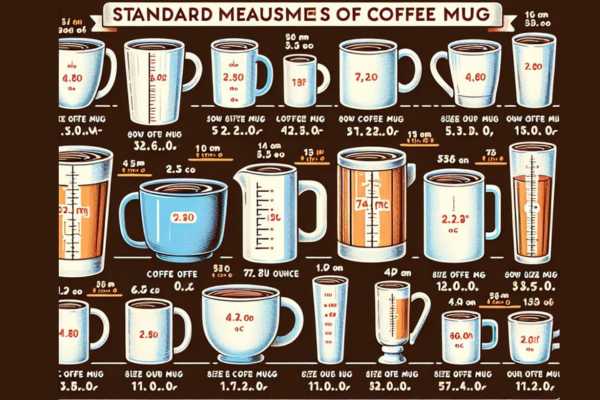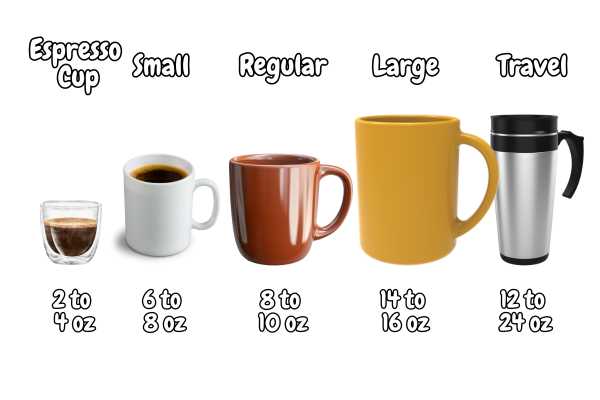So you’re looking to find out how many ounces is a coffee mug? Well, you’ve come to the right place. In this article, we’ll provide you with all the information you need to know about the standard size of a coffee mug. Whether you’re a coffee enthusiast or just trying to figure out the perfect serving size for your morning brew, we’ve got you covered. Let’s dive right in and discover the answer to the age-old question: how many ounces is a coffee mug?
Standard Sizes of Coffee Mugs
Coffee mugs come in various sizes to cater to different preferences and needs. Understanding the standard sizes can help you choose the perfect mug for your coffee-drinking experience. Let’s explore the standard sizes for regular coffee mugs, large coffee mugs, small coffee mugs, espresso cups, and travel mugs.
Regular Coffee Mugs
Regular coffee mugs typically range from 8 to 12 ounces in capacity. These mugs are suitable for a standard serving of coffee and are commonly found in households and coffee shops. They provide just the right amount of coffee to wake you up in the morning or enjoy a comforting cup throughout the day.
Large Coffee Mugs
If you prefer a more substantial serving of coffee, large coffee mugs are the way to go. These mugs usually have a capacity of 14 to 16 ounces, allowing you to enjoy a generous amount of your favorite brew. Large coffee mugs are perfect for those who like to savor their coffee or need an extra boost of caffeine.
Small Coffee Mugs
On the other end of the spectrum, we have small coffee mugs. These mugs are typically around 6 to 8 ounces in capacity and are ideal for those who prefer to have smaller, more frequent servings of coffee. Small coffee mugs are great for enjoying an afternoon pick-me-up or for individuals who prefer a milder caffeine intake.
Espresso Cups
Espresso cups are designed specifically for enjoying shots of espresso. They are small in size, with a capacity ranging from 2 to 4 ounces. These cups are perfect for espresso lovers who enjoy the concentrated flavors and rich aromas of this strong coffee. They also make for a stylish presentation when serving espresso to guests.
Travel Mugs
For those who are always on the go, travel mugs offer a convenient way to enjoy coffee while commuting or traveling. These mugs are usually larger in size, with capacities ranging from 12 to 24 ounces. Travel mugs often feature insulation to keep your coffee hot for longer periods and come with spill-proof lids for ease of use.
Understanding Fluid Ounces
Now that we’ve explored the standard sizes of coffee mugs, let’s dive into understanding fluid ounces. Knowing how many fluid ounces a coffee mug can hold is essential for accurate measurements and brewing techniques.
Definition of Fluid Ounce
A fluid ounce is a unit of measurement used to quantify the volume of liquid in the United States. It is abbreviated as “fl oz” or simply “oz.” One fluid ounce is equivalent to approximately 29.6 milliliters or 1/8th of a cup. Understanding this basic measurement will help you grasp the volume of liquid that can be accommodated in different coffee mug sizes.
Conversion from Fluid Ounces to Other Measurements
It’s worth mentioning that fluid ounces can be converted to other measurements to suit your specific needs. For example, 1 fluid ounce is equal to 2 tablespoons, 6 teaspoons, or 1/8th of a cup. Knowing these conversions can be handy when following coffee recipes or determining the right amount of coffee grounds and water to use.
How Fluid Ounces Differ from Weight Ounces
It’s important to note that fluid ounces and weight ounces are not the same. While fluid ounces measure volume, weight ounces measure mass. To put it simply, fluid ounces calculate how much space a liquid occupies, whereas weight ounces measure the actual weight of an ingredient. When it comes to coffee mugs, we primarily focus on the fluid ounce capacity to determine the volume of liquid they can hold.
Factors Affecting How Many Ounces Is A Coffee Mug
Several factors come into play when determining the number of ounces a coffee mug can hold. Let’s take a closer look at these factors and how they impact the capacity of a coffee mug.
Material Types and Thickness
The material of a coffee mug, along with its thickness, can affect its overall capacity. Ceramic and porcelain mugs are commonly used and come in various thicknesses. Thicker mugs tend to have slightly less volume due to the added materials required for a sturdy design. On the other hand, mugs made of thinner materials like bone china may offer a larger fluid ounce capacity.
Designs and Structures
The design and structure of a coffee mug can also impact its capacity. Certain designs, such as mugs with wider bottoms or larger handles, may result in a slightly reduced volume. Conversely, mugs with narrower bases and streamlined shapes may offer a slightly higher fluid ounce capacity. It’s important to consider the mug’s design when looking for a specific ounce capacity.
Handle Sizes and Positions
The size and position of a coffee mug’s handle can affect its overall fluid ounce capacity. Handles that are larger or positioned further away from the mug’s body may reduce the space available for liquids. Conversely, mugs with smaller handles or handles that are integrated into the mug’s structure may offer a slightly higher fluid ounce capacity.
Lip and Rim Shapes
The shape of a coffee mug’s lip or rim can also impact its capacity. Mugs with thicker or curved rims may have a slightly reduced volume compared to mugs with thinner or straighter rims. The shape of the rim can affect the amount of liquid that can be poured and comfortably consumed from the mug.
Measuring Coffee Mug Capacity
Now that we understand the factors affecting coffee mug ounces, let’s explore the different methods of measuring coffee mug capacity.
Using a Liquid Measuring Cup
Using a liquid measuring cup is one of the simplest ways to measure the capacity of a coffee mug. Fill the mug to its brim with water, making sure not to spill any. Pour the water into the measuring cup and read the measurement in fluid ounces. This method provides an accurate representation of the mug’s capacity.
Using a Scale
If you have a kitchen scale, you can also measure the capacity of a coffee mug by weighing it. Start by weighing an empty mug on the scale and note the measurement in ounces. Then, fill the mug with water and weigh it again. The difference in weight between the empty and filled mug will give you the capacity in fluid ounces.
Using a Tablespoon
In the absence of a liquid measuring cup or scale, you can estimate the capacity of a coffee mug using tablespoons. Fill the mug with tablespoons of water, counting as you go. One tablespoon is equivalent to approximately 0.5 fluid ounces. Once you have filled the mug, multiply the number of tablespoons by 0.5 to determine the mug’s approximate fluid ounce capacity.
Common Ounce Capacities
Coffee mugs come in a wide range of sizes, but there are several common ounce capacities that you’ll often come across. Let’s take a look at some of these capacities and their typical uses.
8-ounce Coffee Mugs
An 8-ounce coffee mug is considered a standard size and is perfect for traditional coffee servings. It accommodates a regular-sized cup of coffee and is commonly used at homes, offices, and coffee shops. If you prefer smaller, more frequent servings of coffee, an 8-ounce mug is a great choice.
10-ounce Coffee Mugs
A 10-ounce coffee mug offers a slightly larger serving of coffee compared to the standard 8-ounce size. This size is versatile and can be used for both regular coffee and specialty beverages like lattes or cappuccinos. The 10-ounce capacity provides a well-balanced serving for those who enjoy a bit more coffee without going too large.
12-ounce Coffee Mugs
The 12-ounce coffee mug is a popular choice for those who like a larger cup of coffee to start their day. It provides a generous serving and is suitable for those who need a bit more caffeine or prefer a larger volume of coffee to enjoy. This size is commonly found in coffee shops and is great for staying energized throughout the morning.
14-ounce Coffee Mugs
If you’re looking for a substantial serving of coffee, a 14-ounce coffee mug might be the perfect fit. This size is ideal for coffee lovers who enjoy a big cup of joe or prefer to have less frequent refills. The 14-ounce capacity allows you to savor your coffee and enjoy its flavors to the fullest.
16-ounce Coffee Mugs
The 16-ounce coffee mug is often referred to as a “grande” size, popularized by certain coffee chains. It offers an even larger serving of coffee, perfect for those who need an extra boost of caffeine or prefer a more substantial amount of coffee throughout the day. The 16-ounce capacity ensures you stay fueled and awake whenever you need it.
20-ounce Coffee Mugs
For the true coffee aficionados, a 20-ounce coffee mug is a great choice. This size is often used for specialty beverages like flavored lattes, iced coffees, or blended drinks. The larger capacity allows for the addition of ingredients like milk, cream, or ice while still providing a generous serving of coffee.
24-ounce Coffee Mugs
If you prefer an exceptionally large serving of coffee or enjoy sharing your coffee with others, a 24-ounce coffee mug is the way to go. This size is commonly used for sharing among friends or for individuals who have a high coffee consumption. The 24-ounce capacity ensures you have plenty of coffee to go around.
32-ounce Coffee Mugs
For those who can’t get enough coffee or need a jumbo-sized cup to power through the day, a 32-ounce coffee mug is the ultimate choice. This size is often found in diners or establishments where large amounts of coffee are needed. The 32-ounce capacity is perfect for those who need a continuous supply of coffee or have a specific brewing strength preference.
Other Considerations
While understanding ounces in a cup is important, there are a few other considerations to keep in mind when choosing the perfect mug for your coffee needs.
Metric Conversions
If you prefer to use the metric system, it’s helpful to be aware of the conversions from fluid ounces to milliliters. One fluid ounce is approximately equal to 29.6 milliliters. Knowing this conversion can assist you in finding mugs with a specific milliliter capacity or to better understand volume measurements in coffee recipes.
Personal Preferences
When it comes to coffee mug sizes, personal preferences play a significant role. Consider the amount of coffee you typically drink and how you like to enjoy it. Some individuals may prefer smaller, more frequent servings, while others may enjoy a larger mug to last them throughout the day. Understanding your personal preferences will help you choose a mug size that suits your unique needs.
Brewing Strengths
Different coffee brewing methods require various ratios of coffee grounds to water. For instance, if you enjoy strong coffee, you may need a mug with a smaller capacity to achieve the desired strength. Conversely, those who prefer milder brews may opt for a larger mug to accommodate a higher coffee-to-water ratio. Adjusting your mug size can help you achieve the perfect brewing strength.
Coffee to Creamer Ratio
If you enjoy adding creamer or milk to your coffee, keep in mind how much space your chosen mug size leaves for these additions. A larger mug may provide ample room for creamer without sacrificing the desired coffee-to-creamer ratio. However, if you prefer a stronger coffee flavor, a smaller mug may be a better option to ensure a balanced ratio.
Benefits of Knowing Coffee Mug Ounces
Understanding the ounces of your coffee mug can offer several benefits and enhance your overall coffee-drinking experience.
Accurate Recipe Measurements
When following coffee recipes, knowing the fluid ounce capacity of your mug ensures precise measurements and consistent results. Whether you’re brewing a classic cup of joe or experimenting with specialty drinks, having accurate measurements eliminates any guesswork and helps you achieve the desired flavors.
Consistent Brewing Practices
Using the same size and ounces of coffee mug each time you brew ensures a consistent coffee experience. The familiar taste, strength, and volume contribute to a sense of comfort and routine. By knowing your mug’s ounces, you can replicate your desired brewing method and maintain a consistent coffee-drinking ritual.
Controlled Caffeine Intake
For those who are conscious of their caffeine consumption, understanding coffee mug ounces allows for better control over your caffeine intake. By choosing a mug size that suits your desired caffeine levels, you can avoid going overboard or feeling deprived. Knowing the ounces of your mug helps you enjoy coffee in moderation and according to your personal preferences.
Portion Awareness
Having a clear understanding of your coffee mug ounces can promote portion awareness and prevent excessive consumption. When you’re aware of how much coffee a mug can hold, you can better gauge how many servings you’ve had or how much more you should have throughout the day. This awareness can contribute to a balanced coffee-drinking routine.
Conclusion
Coffee mugs come in various sizes to suit preferences. Understanding fluid ounces and factors affecting mug capacity helps choose the right size. Measure capacity with cups, scales, or tablespoons. Consider preferences, brewing strengths, and ratios for a satisfying cup. Benefits include accurate recipes, consistent brewing, controlled caffeine, and portion awareness. So the next time you reach for your coffee mug, you can confidently savor each sip, knowing that you’ve chosen the perfect size for your coffee-drinking pleasure.

Continue Reading…
- Discover How Much Caffeine In An Espresso Shot
- Starbucks Cup Sizes – How to Choose Your Perfect Cup Size
- Decoding Ristretto vs Long Shot: Unveiling the Secrets of espresso
- Easy Whipped Coffee Recipe – Elevate Your Morning Routine
- Tips for Perfect Heavy Whipping Cream in Coffee Experience
- Can You Eat Coffee Grounds? Facts, Safety and Benefits
- Is Coffee Good For Sore Throat? Discover the Effects
- Discover How Long Does Coffee Last? 6 Smart Storage Tips
- Perfect Scoop-to-Cup Ratio: How Many Scoops Of Coffee For 12 Cups


